
***These are the stars of Selena***
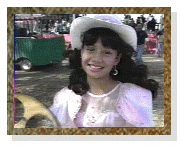
Becky Meza as young Selena

Jennifer Lopez as Selena

Jon Seda as Chris Perez
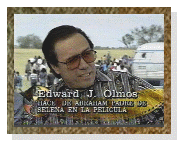
Edward James Olmos as Abraham Quintanilla
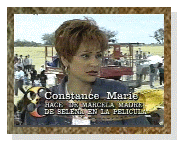
Constance Marie an Marcella Quintanilla
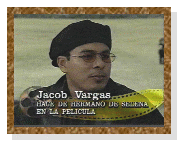
Jacob Vargas and A.B. Quintanilla
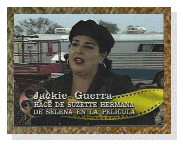
Jackie Guerra as Suzette Quintanilla
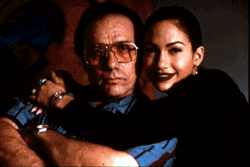
The Making of Selena
Two years after the murder of the Tejano queen, a major movie hits the screen
By Valerie Menard
From the get-go, this film
promised to distinguish
itself from any other effort to capture Selena's bittersweet story. It was orchestrated
by her father, Abraham Quintanilla, Jr., who then handpicked the director, Gregory
Nava (Mi Familia, El Norte), who also wrote the script, and the producer,
Esparza/Katz Productions, headed by Moctezuma Esparza and Bob Katz (The Ballad
of Gregorio Cortez). That Nava and Esparza were two of the most recognized Latinos
in their fields was not a coincidence. Quintanilla openly and deliberately entrusted to
Latino hands the future of this tribute to his daughter.
With a budget of $18 million (small by Hollywood standards but the biggest Nava
has worked with), the director brought in cinematographer Edward Lachman and
associate producers Nancy De Los Santos (Mi Familia) and Carolina Caldera. The
Latino production team next set about casting its lead characters, Selena and Abraham
Quintanilla. In the spirit of the Tejano star, they initiated a national open casting call
for the part of Selena, which brought young Latinas to five major cities with the
chance to play their idol as a 10-year old or a 22-year-old. More than 22,000 Latinas
were screened, but in the end a veteran actress, Jennifer Lopez (Mi Familia, Money
Train), 26, and an unknown actress from South Texas, Becky Lee Meza, 10, would
play Selena. In the role of Abraham is Edward James Olmos, and rounding out the
rest of the cast are Constance Marie (Marcela Quintanilla, Selena's mother), Jon Seda
(Chris Perez, Selena's husband), Jackie Guerra (Suzette Quintanilla Arriaga), Jacob
Vargas (A. B. Quintanilla), and Lupe Ontiveros (Yolanda Saldivar, Selena's former
fan club president and the woman who shot her). All three members of Selena's band
played themselves: singer/songwriter Pete Astudillo, writer Rick Vela, and keyboard
player Art Meza.
Selena's story had such a universal appeal that she was mourned not only by fans but
by Latinos nationwide. A girl who came from humble beginnings, she had great
singing talent and a strong family for support and guidance, which led her to the
brink of nationwide success. She was truly poised for greatness before that fateful
night, March 31, 1995, when she was killed. This is a film that attempts to re-create
the rise and untimely death of one of the brightest stars in Latin music, Ã la La
Bamba. Early predictions are that Selena may exceed La Bamba's unprecedented
success for a Latino film - over $100 million at the box office.
Plainly the script seeks to capture Selena's essence, her genuineness, talent, and
charm that created a deep bond between the singer and her fans. But the script also
incorporates the view of Abraham Quintanilla, the mastermind of his daughter's
success but also the loving father. "Abraham is the consummate father," says Nava,
whose script offers a view into the man maligned by many as a Svengali, in scenes
revealing Abraham's failed attempts to cross over into the mainstream as a musician
and his motivation for pushing music onto his children.
Edward James Olmos and Jennifer Lopez as Abraham
Quintanilla and Selena create a strikingly realistic
father-daughter portrait.
Because of Selena's father's hands-on approach to the film, there was early
speculation that the film would be on a short creative leash and that the story might be
told completely from Abraham's perspective. However, both Esparza and Nava rave
about how supportive and cooperative the senior Quintanilla was. "Abraham knew if
he didn't make this movie, someone would, and it would be exploitive stuff. He
made this movie to preserve his daughter's memory; it's a work of love," says Nava.
"He [Quintanilla] may have been hands-on but he knows when to let people do their
job," Nava adds.
The first clue that this film was one-sided would have been the omission of
controversial moments in Selena's life, however few they may be. In her lifetime,
Selena was known as a good girl who, for the most part, honored her father's
wishes. But in her short life, 23 years, there was one moment of rebellion, the one
time she did what she wanted without her father's okay - she fell in love and
eventually eloped with Perez. The film, rather than ignoring this event, explores
Selena's romance with Perez. "It's a beautiful love story and a very important part of
this movie," says de los Santos.
Even before it opened, the film had already made an impact. It began with the cast
who, as part of their research, spent time with their real-life counterparts. As
Californians, most of the cast and much of the crew, including Nava, were not well
acquainted with the subject of their movie. "We were proud of her as a Chicana, but
we weren't that familiar with her music," asserts the director. Spending time with the
Quintanillas, especially in their hometown of Corpus Christi, revealed to the actors
how important Selena was to her family as well as her fans.
Wearing signature fashion statements, many times borrowed from the respective
Quintanilla, each actor displayed signs of the relationships he or she formed with their
nonfiction double. A. B. Quintanilla lent Vargas his trademark sunglasses and
jewelry; Perez lent Seda his own guitar, a Fender Telecaster, and coached him on the
proper fingering for the instrument; and Suzette chose Guerra's entire wardrobe.
"Suzette helped me a lot," says Guerra. "She would explain the background of what
was going on, and she showed me how she holds the [drum] sticks." Guerra, who
wasn't the first choice to play Suzette, adds that even before she met Selena's older
sister, she wanted the part very badly. Meeting Suzette only confirmed to Guerra that
she was meant to play her. "It was strange when we ordered the exact same thing . . .
we even had on the exact same shoes. At first I thought it was kind of creepy that me
and Suzette were so similar, but then I thought this is what twins separated at birth
must feel like."
Aided by Selena's own fashions and the family's home videos, Lopez adopted the
singer's manners handily. The enormity of the role she was playing seemed to sink in
more each day. Capturing Selena's "essence" says Lopez, was a greater challenge.
"This movie is the celebration of the life of an amazing person. Selena was someone
who had not just tremendous talent but also a beautiful heart, and I think that's what
her fans loved most about her. I knew her memory was still fresh in their minds, so
the most important thing for me was to get it right."
As the film progressed, the actors' education on Selena the icon continued. Once in
Texas, the cast not only learned about it, they witnessed the undying Selena legacy.
"I couldn't go anywhere with Suzette in South Texas without people coming up to
her and praying for her and telling her how sorry they were Selena was killed,"
relates Guerra. "She's [Selena's] like Elvis out there." In concert scenes the actors
were also overwhelmed by the crowd reaction. As the cameras began rolling, fans
could hear Selena singing (Lopez does not sing in the movie), and when Lopez came
out on stage in full-Selena makeup and costume the likeness was so close that their
faces filled with joy. They had one last chance to say good-bye, and the emotional
range brought on by this closure was not lost on the actors or their director. "You
could see the response, even among 35,000 extras, how deep it ran, how profound,"
Nava says.
Selena and the communities that welcomed the film crews shared a symbiotic
relationship. Filmed in San Antonio and Corpus Christi, the production hired extras
and some crew members locally. Sergio Moreno, Jr., owner of his own salon,
Diamond Kut, and Terry Machado from San Antonio were subcontracted as hair
support staff to the film's chief makeup artist, Academy Award-nominated Mark
Sanchez. "I'm thrilled to be working with Mark," says Machado. Her regular clients
did miss her, but they understood what a great opportunity the film was. "I told them
they were spoiled. They've had me any time of day," says Machado. "But because of
the movie, they said they forgive me."
Emma Benavides remembers seeing an ad calling for extras and crew members. Her
son, Jonathan, she says, would like to be a writer someday, possibly doing
screenplays, so she encouraged him to report to the local grocery store where
interviews were being held and see if he could get a job working on the movie.
Jonathan took his friend Robert Robles, who has an acting bug and both were hired
as stand-ins - they stand in place of the actors to hold their spot while the crew makes
adjustments between takes and during setups. Paid $100 a day, Benavides says he
enjoyed the experience, talking to Nava and the actors; for Robles, Seda was his
favorite. "He had the least attitude," he says.
Studio heads were so pleased the film's rough cuts that they rushed the release date to
March 21. Selena will not be the first Latino film to make money. Mi Familia tripled
its cost of $5 million at the box office without the support of a nationwide release,
and Cheech Marin's Born in East L.A. also surprised Hollywood with its success.
What Selena promises to do is tell a compelling story from a sensitive point of view,
showcase Latino talent - some old, some new - and for those who still mourn her
death, give them a chance to say good-bye.